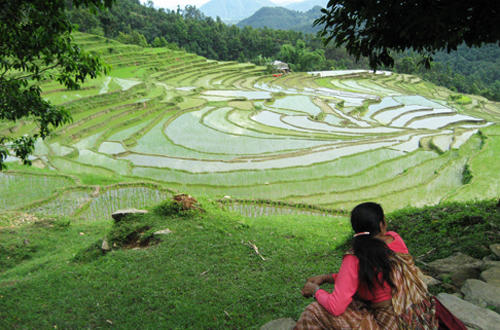Promoting agricultural biodiversity on the mountains of Nepal

A new catalogue provides easy reference to diverse crop varieties adapted to mountain agriculture in Nepal to promote a growing demand for agricultural biodiversity, even at high altitudes.
A new catalogue provides easy reference to diverse crop varieties adapted to mountain agriculture in Nepal to promote a growing demand for agricultural biodiversity, even at high altitudes.
Around 65% of the Nepalese population earn their living from agriculture. Because of their complex and geographically diverse farming systems, Nepalese farmers need a rather comprehensive portfolio of crop varieties with disparate traits. The climatic variation and different ethnic groups in Nepal allow for the cultivation of diverse forms of crop species but this information is not easily available, and many farmers do not have access to it due to the lack of updated websites or publications of national crop varieties list/catalogues.
The catalogue for mountain agriculture in Nepal, which refers to altitudes of more than 1500 metres above sea level, compiles information on varieties of crop species that are very important in mountain agriculture including amaranth, barley, beans, buckwheat, finger millet, foxtail millet, maize, potato, proso millet, rice and wheat. It includes the varieties' unique trait combinations, adaptive capacity to environmental constraints, taste and other cultural uses, with the ultimate purpose of maximizing the benefits of public research investments, and serving as an important repository for varietal information of mountain crops of Nepal.
A valuable resource aimed at researchers, development professionals, planners, field staff as well as farmers, variety catalogues are very useful in agriculture research and development, and help empower communities to restore and sustainably manage their own landscapes to meet their needs. They provide easy access for farmers, seed producers, suppliers and extension officials to pertinent information, increasing demand for and encouraging the growing of different species and varieties, promoting a healthy and productive food system. Incorporating agricultural biodiversity into farms will thus provide nutritious diets and generate income, creating benefits for the farmers, consumers and the environment, while safeguarding this precious, and threatened, resource for future generations.
This publication was produced by the Bioversity International in collaboration with Nepal Agricultural Research Council (NARC), Department of Agriculture (DoA) and Local Initiatives for Biodiversity, Research and Development (LI-BIRD).
Download the catalogue here:
Released and Promising Crop Varieties for Mountain Agriculture in Nepal (1959-2016)
Partners
This publication was possible thanks to funding from the United Nations Environmental Programme, Global Environmental Facility (UNEP-GEF) and the Swiss Agency for Development and Cooperation (SDC), the Nepal Agricultural Research Council (NARC), Department of Agriculture (DoA), Seed Quality Control Centre (SQCC) of the Ministry of Agriculture Development, and Local Initiatives for Biodiversity Research and Development (LI-BIRD).
This research is part of the CGIAR Research Program on Water, Land and Ecosystems and is supported by CGIAR Fund Donors
Photo caption and credit: Rice terraces in Nepal. IRRI/B.Bouman
